IPv4 vs IPv6 - What are the Differences?
An IP (Internet Protocol) address is a numerical label which is used for addressing he location and identification of the network interface for the devices connected to the computer network.
The most used and popular IP version is IPv4 which uses 32-bit for IP addresses. Since the IPv4 became popular and the IPv4 addresses are getting depleted, Ipv6 is now used which uses 128-bit for the IP addresses.
The IP addresses are assigned to each devices connected in a network by the network administrators.
You can find your device IP address with following online and free tool - What is my IP Address. It will show your Public IP address along with your location.
An IP address will look like this:
192.168.10.1Table of Contents
- What is IPv6?
- Characteristics of IPv6
- What is IPv4?
- Characteristics of IPv4
- IPv6 vs IPv4
- Types of IPv6
- Advantages of IPv6
What is IPv6?
IPv6 (Internet Protocol Version 6) is the recent version of the Internet Protocol(IP). IP is the communication protocol for routing and addressing packets of data that travel across the networks.
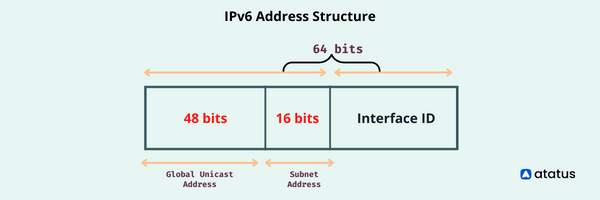
An IP address is a digital address for the network for the computer to let know the internet where to send emails and data.
An IP address is used to determine where you are in the network of digital devices connected to the internet.
Here's how an IPv6 address looks like:
2402:3a80:436:abc5:7852:b170:8c9a:6458Characteristics of IPv6
- It has a 128-bit address and has large address space.
- It has a simplified header by moving all unnecessary information to the end.
- It is called IPsec which is Ip security, making it more secure than IPv4.
- Ipv6 header is more extensible.
- It has enhanced priority support.
What is IPv4?
IPv4(Internet Protocol Version 4) is one of the core protocols used in networking methods on the Internet and other packet-switched networks which was introduced by the Internet Engineering Task Force(IETF) in 1982. It is the most widely used protocol and runs almost 94% of the network traffic.
The IPv4 address will look something like this:
192.168.100.32Characteristics of IPv4
- Ipv4 is a 32-bit IP address
- It is a numeric address, separated by a dot.
- IPv4 protocol supports the Virtual Length Subnet Mask.
- Networks in this protocol are to be designed either manually or with DHCP (The Dynamic Host Control Protocol).
IPv4 vs IPv6
The common type of IP address is IPv4. The IPv4 address looks like this:
192.168.29.68
The IPv4 address consists of four numbers, each of which has 1 to 3 digits separated by a single dot(.) and each number can range from 0 to 255. The IPv4 protocol uses a 32-bit address that can store 2^32 addresses, which rates more than 4 billion addresses.
Whereas, IPv6 consists of eight groups of four hexadecimal digits. The IPv6 address looks like the one below.
2405:201:e03b:8ab:9017:fd75:a746:9a4bThough IPv4 is the primary protocol that manages almost more than 94% of the traffic and seemed like it would never run out of address, IPv6 has paved the way to provide more internet addresses than IPv4. IPv6 has 128-bit address space which can hold 340 undecillion unique addresses.
Difference between IPv4 and IPv6
| IPv4 | IPv6 |
|---|---|
| Ipv4 has a 32-bit IP address. | Ipv6 has a 128-bit IP address. |
| Ipv4 is a numeric address separated by a dot(.) | Ipv6 is an alphanumeric address separated by a colon(:) |
| IPv4 does not have encryption or authentication. | IPv6 provides encryption and authentication. |
| IPv4 supports Variable Length Subnet Mask(VLSM) | Ipv6 does not support Variable Length Subnet Mask(VLSM) |
| IPv4 uses Address Resolution Protocol(ARP) to map to MAC address. | Ipv6 uses Neighbour Discovery Protocol(NDP) to map to the MAC address. |
| Since IPv4 uses dot-decimal notation, it is not suitable for mobile networks. | Since IPv6 uses hexadecimal and colon-separated notation it is suitable for mobile networks. |
Types of Ipv6 address
Let us have a look at the types of addresses in IPv6.
Unicast Address
These Unicast addresses are globally identifiable and uniquely addressable. In this type of addressing, the IPv6 interface is uniquely identified by a network segment.
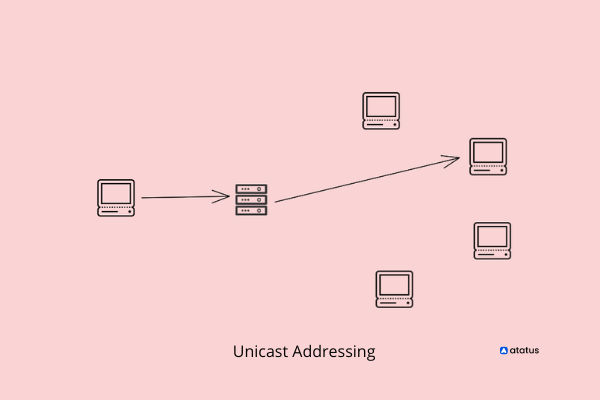
When a router or a network switch receives a unicast IP packet, that is destined for a single host, it then sends out one of its outgoing interfaces which will connect to that particular host.
This address identifies the set of interfaces so that when a packet is sent to an anycast address, it is delivered to a member of the set. It is typically assigned to a set of interface which belongs to different nodes.
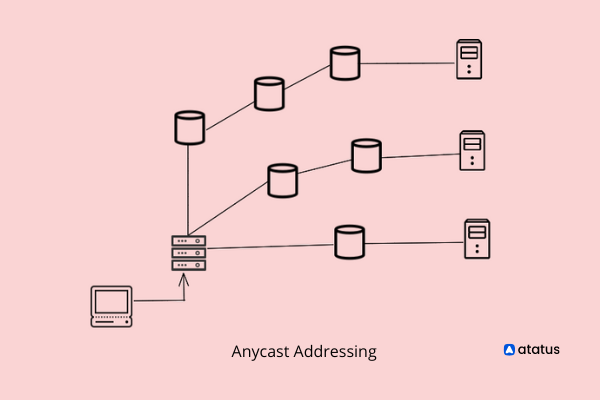
In this addressing, multiple interfaces are assigned the same anycast IP address. When a host needs to communicate with a host which has an anycast address, it sends a unicast message to it. The unicast message is delivered to the host which is closer to the sender in terms of the routing cost.
Multicast Address
This address identifies a group of interfaces so that when a packet is sent to a multicast address, it is sent to all the interfaces present in the group.
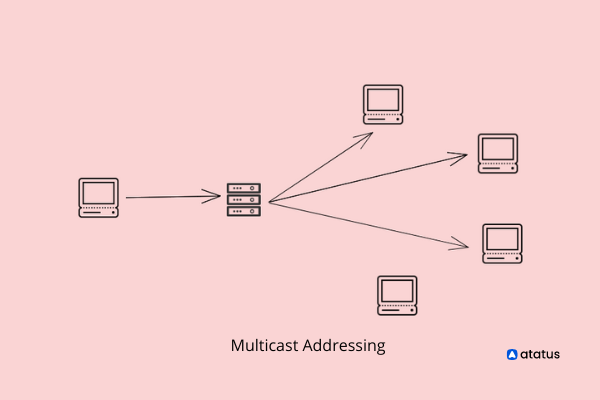
The packets which are destined for multiple hosts are sent to the special multicast address. All the hosts are interested in the multicast information and they join the multicast group. The interfaces which joined the group receive the multicast packet and then process it while the other hosts which are not interested in the multicast information ignore it.
Advantages of IPv6
- IPv6 provides more addresses than Ipv4.
- In IPv6, there is no NAT(Network Address Translation).
- It has a simple header format.
- In IPv6, private address collisions are avoided.
- The multicast routing in IPv6 is way better than in Ipv4. Because of this, bandwidth-intensive packets are sent to multiple destinations at once.
- There is stronger IP security which provides confidentiality and data integrity which are all embedded in IPv6.
- There is a built-in authentication in IPv6 along with privacy support.
- The routing is simplified and more efficient in IPv6.
IPv6 adoption statistics
Statistics about IPv6 availability for Google users are maintained by Google according to country. Rather than IPv4, IPv6 constitutes a large percentage of all traffic to Google sites.
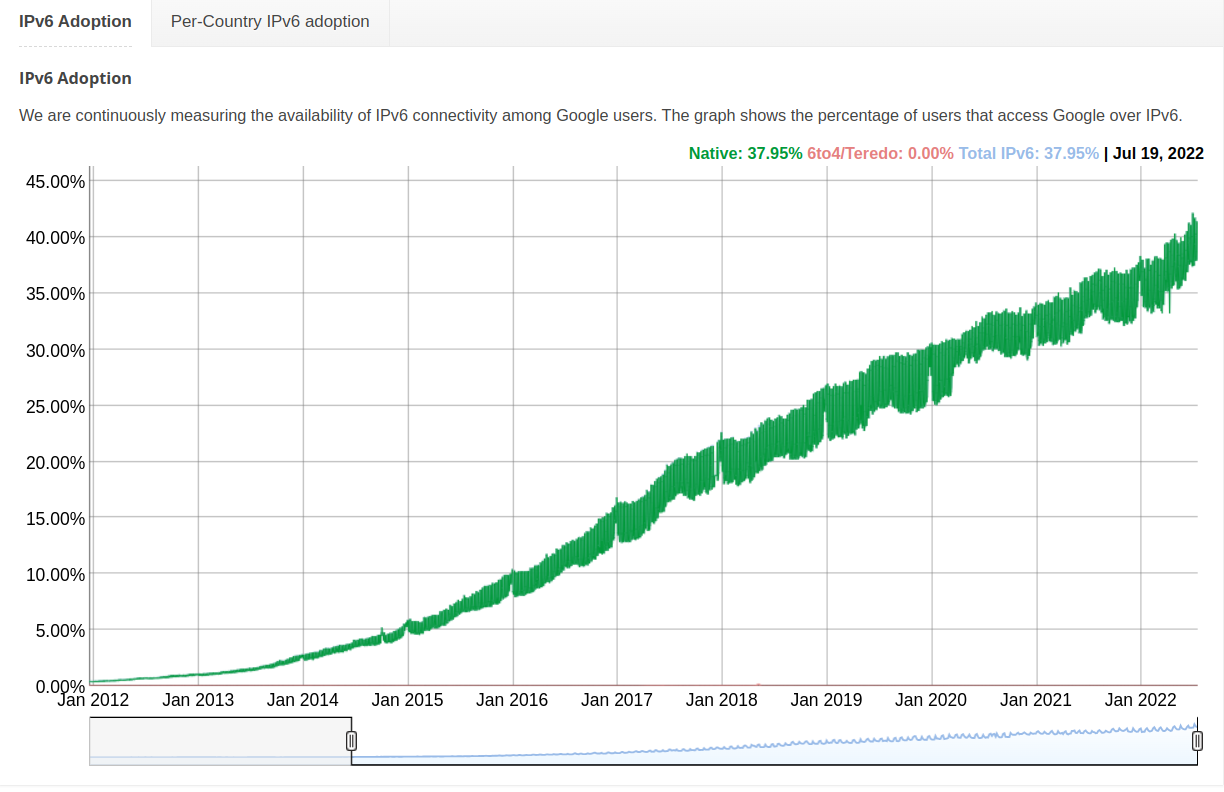
In recent years, many countries have migrated to the latest version of the Internet Protocol (IP). Google's Per-Country IPv6 Adoption Statistics shows France has the highest IPv6 adoption percentage at 72.22%.
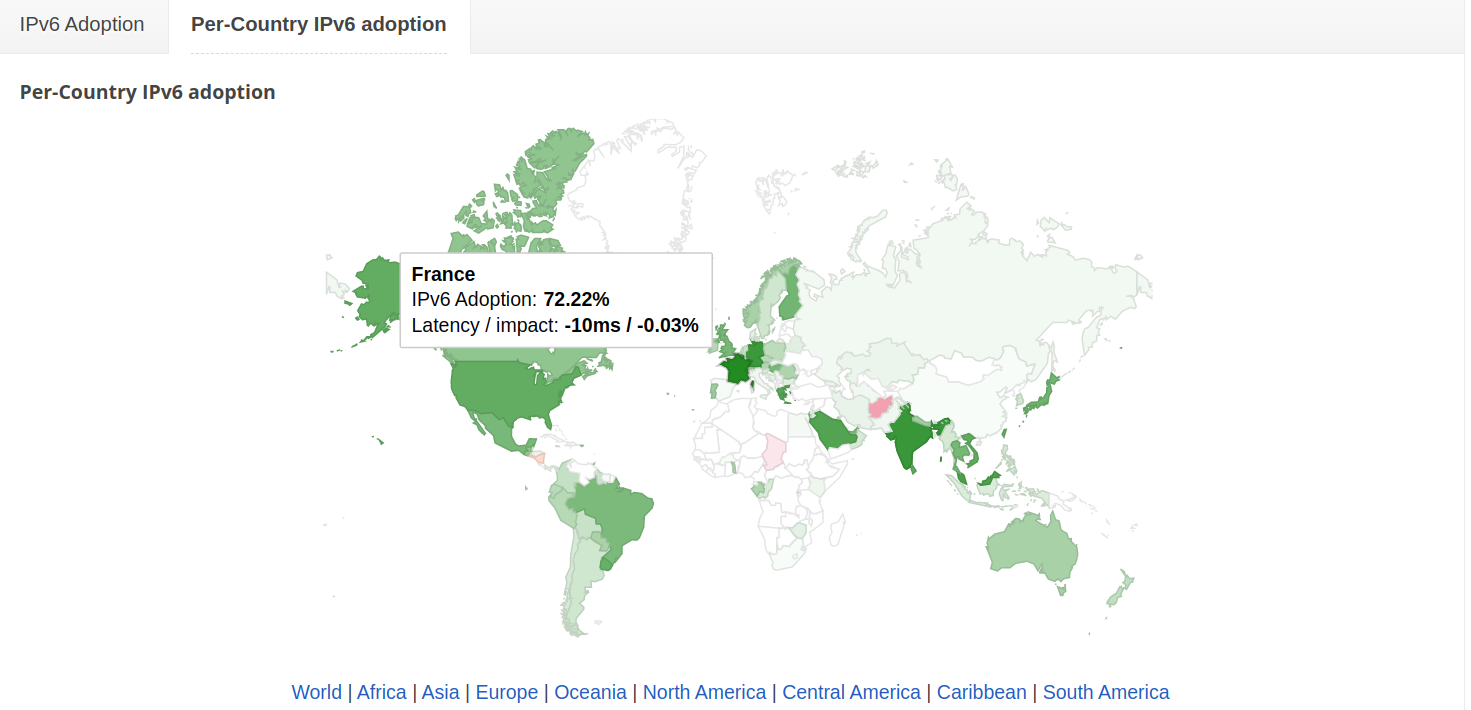
As with France, India is also experiencing a steady increase in IPv6, currently at 64.69%.
Nevertheless, according to Google's IPv6 adoption statistics, IPv6 is not yet available at a global scale beyond 40% in the early part of 2022.
Conclusion
IPv4 is the most used protocol till now. When it was launched, it seemed that IPv4 has enough addresses for the entire devices on the internet.
As the internet exploded and made a great impact in our world, every country started using the internet which resulted in the need for IPv6.
IPv6 being a 128-bit address has more address space than IPv4 which will meet the need of providing the address for every device on the internet.
IPv6 is designed in a way to expand today’s internet services. The IPv6-enabled Internet version2 is feature rich and can replace the IPv4 version.
IPv6 has IPsec which means there is security for our IP address which increases the confidentiality of Ipv6. These features of IPv6 are greater than IPv4 and have more advantages too.
Monitor Your Entire Application with Atatus
Atatus is an Observability Platform that lets you review problems as if they happened in your application. Instead of guessing why errors happen or asking users for screenshots and log dumps, Atatus lets you replay the session to quickly understand what went wrong.
We offer Application Performance Monitoring, Real User Monitoring, Serverless Monitoring, Logs Monitoring, Synthetic Monitoring, Uptime Monitoring, and API Analytics. It works perfectly with any application, regardless of framework, and has plugins.

Atatus can be beneficial to your business, which provides a comprehensive view of your application, including how it works, where performance bottlenecks exist, which users are most impacted, and which errors break your code for your frontend, backend, and infrastructure.
If you are not yet a Atatus customer, you can sign up for a 14-day free trial
#1 Solution for Logs, Traces & Metrics
APM
Kubernetes
Logs
Synthetics
RUM
Serverless
Security
More


